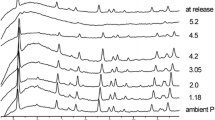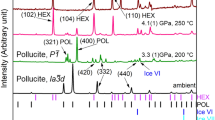Abstract
The high-pressure structural evolution of hemimorphite, Zn4Si2O7(OH)2·H2O, a = 8.3881(13), b = 10.7179(11), c = 5.1311(9) Å, V = 461.30(12) Å3, space group Imm2, Z = 2, was studied by single-crystal X-ray diffraction with a diamond anvil cell under hydrostatic conditions up to 4.2 GPa. In the pressure range of 0.0001–2.44 GPa, the unit-cell parameters change almost linearly. The phase transition (probably of the second order) with symmetry reduction from Imm2 (hemimorphite-I) to Pnn2 (hemimorphite-II) was found near 2.5 GPa. The structure compressibility increases somewhat above the phase transition. Namely, the initial unit-cell volume decreases by 3.6% at 2.44 GPa and by 7.2% at 4.20 GPa. The hemimorphite framework can be described as built up of secondary building units (SBU) Zn4Si2O7(OH)2. These blocks are combined to form the rods arranged along the c-axis; these rods are multiplied by basic and I-translations of orthorhombic unit cell. The symmetry reduction is caused by the rotation of the rods along their axis. In hemimorphite-I, the compression affects mainly the SBU dimensions, whereas a rectangular section of the channels having mm2 symmetry remains practically unchanged. An appreciable decrease in this section in hemimorphite-II is determined by its oblique distortion with the loss of m planes. It results from opposite rotation of adjacent SBU, which also leads into the loss of I-translation. In hemimorphite-I, the coordination of H2O molecules is fourfold planar; the hydrogen-bonded hydroxyls and H2O molecules form infinite ribbons along the c-axis. In hemimorphite-II, an additional short H2O–O contact appears as a result of asymmetric deformation of the channels. The appearance of this new contact provides the possibility for re-orientation of hydrogen bonds. The planar coordination of H2O molecules changes to tetrahedral and the ribbons are transformed to islands (OH)2–H2O.





Similar content being viewed by others
References
Angel RJ (2004) Absorption corrections for diamond-anvil pressure cells implemented in the software package Absorb6.0. J Appl Cryst 37: 486–492. doi:10.1107/S0021889804005229
Boehler R (2006) New diamond cell for single-crystal x-ray diffraction. Rev Sci Instrum 77: art. No. 115103. doi:10.1063/1.2372734
Budzianowski A, Katrusiak A (2004) High-pressure crystallographic experiments with a CCD detector. In: Katrusiak A, McMillan PF (eds) High-pressure crystallography. Kluwer Academic Publishers, Dordrecht, pp 101–112
Hill RJ, Gibbs GV, Craig JR, Ross FK, Williams JM (1977) A neutron-diffraction study of hemimorphite. Z Krist 146:241–259. doi:10.1524/zkri.1977.146.4-6.241
Kolesov B (2006) Raman investigation of H2O molecule and hydroxyl groups in the channels of hemimorphite. Amer Miner 91:1355–1362. doi:10.2138/am.2006.2179
Libowitzky E, Schultz AJ, Young DM (1998) The low-temperature structure and phase transition of hemimorphite, Zn4Si2O7(OH)2·H2O. Z Krist 213:659–668. doi:10.1524/zkri.1998.213.12.659
McDonald WS, Cruickshank DWJ (1967) Refinement of the structure of hemimorphite. Z Krist 124:180–191. doi:10.1524/zkri.1967.124.3.180
Oxford Diffraction (2008a) Oxford Diffraction Ltd, Xcalibur CCD system, CrysAlis Software system. Abingdon, England
Oxford Diffraction (2008b) CrysAlisRED. Oxford Diffraction Ltd, Abingdon, England
Piermarini GJ, Block S, Barnett JD, Forman RA (1975) Calibration of the pressure dependence of the R 1 ruby fluorescence line to 195 kbar. J Appl Phys 46:2774–2780. doi:10.1063/1.321957
Sandomirsky PA, Belov NV (1984) Crystal chemistry of mixed anion radicals. Nauka, Moscow
Sheldrick GM (2008) A short history of SHELX. Acta Crystallogr A64:112–122. doi:10.1107/S0108767307043930
Takeuchi Y, Sasaki S, Joswig W, Fuess H (1978) X-ray and neutron diffraction study of hemimorphite. Proc Jpn Acad Ser B 54:577–582. doi:10.2183/pjab.54.577
Acknowledgments
The authors thank B. A. Kolesov (Institute of Inorganic Chemistry, Novosibirsk) who kindly provided the sample of hemimorphite. This work was supported by the Russian Foundation for Basic Research, grant # 10-05-00483.
Author information
Authors and Affiliations
Corresponding author
Electronic supplementary material
Below is the link to the electronic supplementary material.
Rights and permissions
About this article
Cite this article
Seryotkin, Y.V., Bakakin, V.V. Structural evolution of hemimorphite at high pressure up to 4.2 GPa. Phys Chem Minerals 38, 679–684 (2011). https://doi.org/10.1007/s00269-011-0440-5
Received:
Accepted:
Published:
Issue Date:
DOI: https://doi.org/10.1007/s00269-011-0440-5




